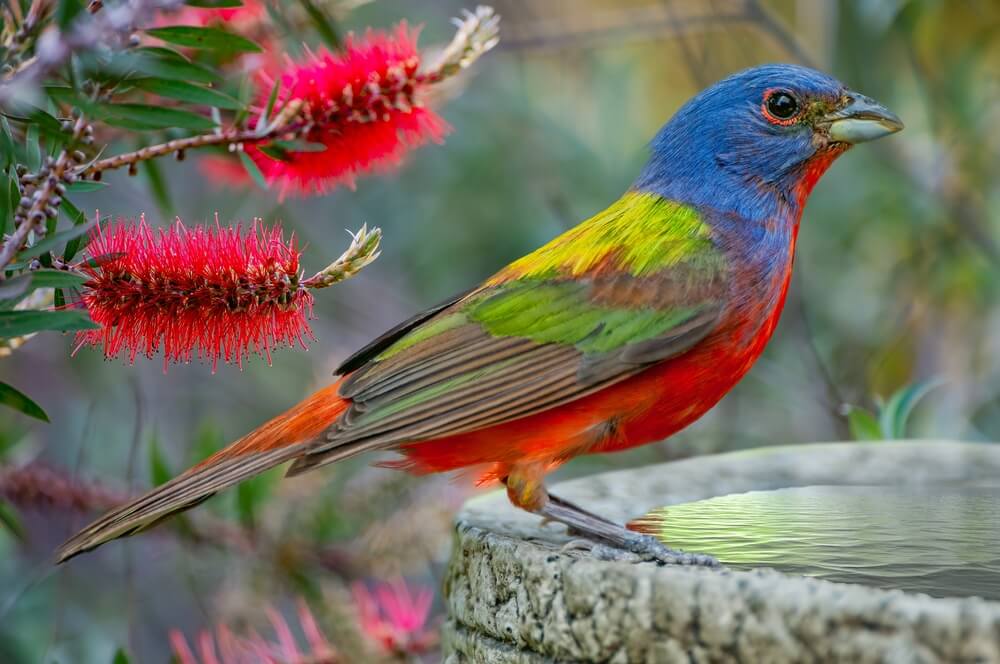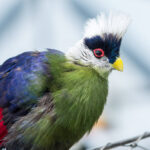Painted buntings look like an escaped bird from a Picasso painting. These vividly rainbow-colored birds are a beautiful sight to see.
They are typically found in the southeastern or south-central parts of the United States.
There are many amazing characteristics of the painted bunting. Read on to learn more about these rainbows in flight.
1. Female Painted Buntings Are Beautiful But Not “Painted”

Painted buntings are sexually dimorphic, meaning females and males do not have the same coloration.
Female painted buntings are a beautiful lime or yellow-green coloration. They have a lighter-toned underbelly.
Females are unpatterned. However, their green color is brighter than other female songbirds’ overall coloration. They have a pale lemon-green eye ring.
2. Male Juvenile Painted Buntings Look Like Females
All painted burning juveniles, including juvenile males, are green like the females.
In their second year of life, males molt into their vivid colors.
3. Their Name Represents Their Characteristics In Several Languages
Male Painted Bunting Appearance
The male-painted buntings are incredibly, vividly colored. They are a mixture of blue, green, yellow, and red, looking as if they were painted with bold colors.
Their heads are blue, their underparts are red, and their backs are green with yellow tones. Their wings and tails are darker shades of green with brown feathers. They have a red-eye ring.
Languages To Describe Them
In English, the word “bunting” refers to songbirds but is also a word for a fabric woven for festive decorations. Painted buntings are most certainly a singing blend of festive colors.
The French name for this bird is “Passerin nonpareil”. Passerin refers to perching songbirds, and nonpareil means having no equal or unrivaled. This indicates that there is no other bird like this one.
In Spanish, this bird is called “Azulillo sietecolores”. Azulillio is the name given to bunting birds, but is also loosely translated as “little blue thing”. Sietecolores is the combination of two separate words: siete and colores. These words translate as 7 colors.
Their Latin scientific name is Passerina ciris, which means “sparrow-like bird”. Sparrows are seed-eaters with conical beaks and beautiful songs, which also describes the painted bunting.
4. Painted Buntings Can Be Hard To Find

The females and juveniles easily camouflage with green vegetation.
Despite the bold coloring of the males, they can also be difficult to locate.
These birds are secretive and often lurk, or hide amongst dense brushy areas or understory and woodland edges in late spring and summer. They like wild, unkempt spaces.
Painted buntings in coastal regions will inhabit areas such as fallow farmland, shrubby backyards, and wooded dunes.
During migration (fall) and winter, these birds often are found foraging for seeds from weedy fields and backyard bird feeders. This is one of the best opportunities to see one.
5. They Spend Their Summers In Parts Of The United States
In the spring, painted buntings leave their southern winter grounds. They travel from Central America, southern Mexico, the Caribbean, and the southern tip of Florida for breeding grounds.
They travel to 1 of 2 breeding ground locations: south-central or southeastern.
South-central painted buntings spend their summers in Texas, Arkansas, Oklahoma, Louisiana, and western Mississippi (as well as northern Mexico).
Southeastern painted buntings are found in North and South Carolina, Georgia, and northern Florida.
While unusual, painted buntings can find their way into the northern parts of the United States. For example, one was spotted in New York City in 2015.
6. Painted Buntings Need Protein Sources In Their Diet
While this bird’s diet is high in seed consumption, they supplement with insects, especially during the nesting season.
Eating higher levels of protein helps these birds maintain strong health to lay healthy eggs. They consume insects such as beetles, grasshoppers, flies, caterpillars, and more.
Offspring need higher levels of protein from when they hatch and as they grow to adult size. Protein sources help birds grow strong fathers for flight.
Fats that accompany essential protein sources promote feather coloration and body insulation.
In midsummer, painted buntings eat seeds after the breeding season is over. They forage on the ground, in shrubs, low trees, and bird feeders in yards with low and dense vegetation. They may also eat berries and fruits.
When migrating, they may forage in mixed flocks.
Check out this video of a male and female painted bunting eating some seeds:
7. Males Will Fight To The Death Over Breeding Territories
Breeding season occurs from May through the middle of July. Males establish breeding grounds by claiming territories of 3 to 8 acres, using songs, displays, and a willingness to fight.
Male painted buntings fight other intruding males by pecking, striking, and grappling, with claws and wings. These confrontations are so fierce that one of the males may die.
Females may even be victims of attacks when it is not the breeding season.
8. The Population Of Painted Buntings Faces Threats
Despite laws that prohibit the capturing and trading of painted buntings, it still happens today in tropical areas. This practice puts negative pressure on natural breeding practices.
Additionally, cowbirds often parasitize the nests of painted buntings. They leave their eggs in the nests, forcing the parents to foster a larger brood that results in less or no care for the painted bunting’s offspring.
Predators such as strikes, snakes, and hawks will raid and eat their eggs.
Habitat loss on breeding grounds and migration sites is also causing a decline in the painted bunting population. They also suffer injury or death from collisions with windows.
9. Only Male Painted Buntings Sing

The males are the only ones that warble and sing. However, if you see a green-painted bunting singing, it is likely a juvenile male.
They produce short, musical phrases of thin, high-pitched melodious notes about 2 seconds long each.
Males and females make calls that sound like a “pwip” or metallic “chip”.
10. Some Migrating Painted Buntings Have An Unusual Migration-Molt Pattern
Waterfowl commonly molt after the breeding season and before they migrate. This is rare for songbirds, yet the painted bunting does this in some regions.
The south-central region of painted buntings starts migration before molting. They stop to shed feathers in northern Mexico, before continuing migration south.
Painted buntings migrating from the eastern-region molt before migration.
11. Female Painted Buntings Do Most Of The Work To Raise Several Broods

The female builds a cup-shaped nest typically in dense shrubbery, vines, or lower portions of trees about 3 to 9 feet from the ground. The nest is made of woven materials consisting of weeds, leaves, and grass.
It is lined with grass, animal hair, and rootlets. She lays 3 to 4 eggs that are white, bluish-white, or pale gray with reddish-brown spots concentrated on the larger end.
She then incubates the eggs for 11 to 12 days. She feeds the chicks, and the hatchlings leave the nest 12 to 14 days later. She may reuse the nest for the next brood or build a new one.
Females often lay 2 broods a year, sometimes 3, and may attempt a fourth.
12. Males May Share Their Territory With More Than 1 Female

Painted buntings often pair up during the breeding season, but males also exhibit polygamous behavior. The females that mate with a single male live all together in the males’ territory.
Males may take over feeding a brood if a female is starting a second nest, but often the female waits for the hatchlings to leave the nest.
13. Painted Buntings Are Related To Cardinals

Painted buntings are in the same family of Cardinalidae as Northern Cardinals. They both belong to the class Aves (birds) and Passeriformes (perching birds).
There are 2 subspecies of painted buntings based on where they breed:
- Passerina cirir ciris (southeastern United States)
- Passerina cirir pallidior (south-central United States)
14. Their Wings Are Nearly Double Their Body Length

Painted buntings are approximately 4.7 to 5.5 inches long.
Their wingspans, however, are nearly double at 8.3 to 9.1 inches wide.
15. Painted Buntings Show Off Their Wings Like Butterflies & Moths

Visually, painted buntings are beautiful in flight. Not only are the colors striking, but they have unique flight patterns. They bounce in flight with slow butterfly-like movements.
Painted buntings display body fluff with upright posturing, bowing, or quivering their wings like a moth’s flight.
16. They Can Live Up For A Decade
The average lifespan of a painted bunting is about 10 years if they are not exposed to the threats mentioned above.
The oldest male painted bunting on record is 14 years old from a banding study in Georgia in 2016.
Conclusion
Painted buntings are art projects with wings.
These beautiful birds are unique with their molting patterns, and social and breeding behaviors. They are quite the sight to see if a person is lucky enough to have one visit a backyard feeder.











